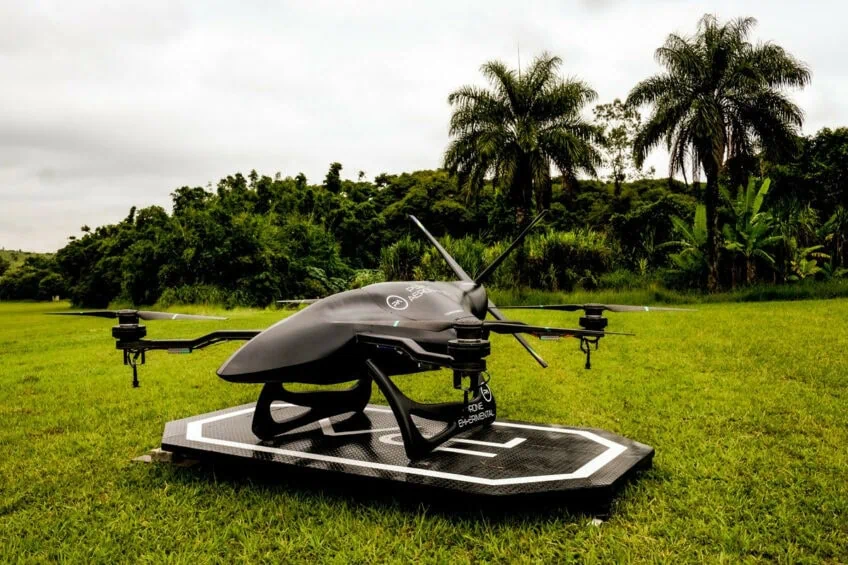Harpia-71 drone: “As big as Brazilian agriculture needs”

Large areas need scalable solutions. That´s why the startup Psyche Aerospace presented, in March this year, the Brazilian candidate for the World´s biggest agricultural VTOL drone.
As a result of six months of development, the Harpia P-71 aims for ´higher flights´ not only for itself but for agricultural spraying as an activity. The proposal already convinced one of the largest sugarcane producers with activities in Brazil: the Tereos Group, which grows 170,000 hectares.
In that case, size makes a difference. According to Psyche Aerospace, Harpia P-71 can reach a maximum takeoff weight of up to 720 kg, distributed across 160 kg of aircraft, 200 kg of fuel and up to 400 kilograms of spray.
That is possible because the equipment has four rotors with the strength to fly up to 180 kg each at an operational speed of 85 km/h and a cruising speed of 160 km/h.
Tereos Group invests in the candidate of the World´s biggest agricultural drone’
The recommendation is for Harpia P-71 to operate at heights between 4 and 6 meters during spraying and to cruise between 80 and 100 meters for a flight autonomy of up to 10 hours.
Psyche Aerospace operates the equipment SaaS (solution as a service) with price of 4 euros per hectare for each application. Currently, they are dealing to cover 2 million hectares with other agricultural groups in Brazil.
Sugarcane leader
Tereos is one of the leading companies in Brazil in the production of sugar, ethanol and bioenergy generated from sugarcane biomass. It is part of the French group Tereos, which operates 41 industrial units in 15 countries.
In Brazil, they have six sugarcane processing units in operation, located in the northwest of the state of São Paulo, around São José do Rio Preto municipality.
“We strongly believe that drones and UAVs are revolutionizing agriculture, and we have a solid history of pioneering and very successful adoption of new agricultural technologies”, says Carlos Simões, director of Agriculture and Strategic Planning at Tereos.
Simões says the company was the first in the sugar-energy sector to use UAVs and drones in agricultural operations a decade ago.
“We currently use UAVs for imagery and remote sensing of sugarcane fields, and artificial intelligence algorithms to analyze and identify anomalies. In addition, drones distribute cotesia (a beneficial insect) and apply some agricultural inputs”, explains.
With more scale, Tereos expects significant cost reductions through a more efficient, rational and less wasteful application of inputs. That means gains in agricultural productivity generated by higher quality in input applications and less soil compaction and fossil fuels usage.
Technical challenging
According to Victor Galvão, master in engineering and responsible for the technology and engineering of the Harpia-71, the development of the vant represented an enormous challenge due to the structure and robustness of the eVTOL.
“We were excited to do something new and challenging. Currently, there are no references for large drones. Everything we did was unprecedented, with all the variables that the design of an eVTOL requires, but with the complexity and dimensions much greater than conventional models”, he states.

Pilot experience
Gabriel de Paula was the pilot responsible for the first flight of the equipment. “Flying the P-71 represented a great challenge that required a lot of focus and attention. Being able to lift and stabilize one of the largest agricultural drones in the World gave me great personal satisfaction”, he concludes.
According to him, the team had no reference for operating this size of drone, nor such sensitive controls. “It was a responsibility both for the structural safety of the drone and for the people involved in the project,” he says.
Big as Brazilian agriculture
For the company’s process director and co-founder, João Barbosa, the dimensions and robustness of the Harpia P-71 have a clear justification.
“To serve Brazil, we need to have the biggest, this is the starting point. The objective is not necessarily to be the biggest in the world, it is to be the size of Brazil’s productive area,” he says.
The startup is in one of the largest aerospace hubs in the World, the São José dos Campos Technological Innovation Park and has a 2,000-square-meter factory in the south zone of the same city. The city is also home to, for example, the Aeronautical Technological Institute (ITA) and Embraer.
Join 17,000+ subscribers
Subscribe to our newsletter to stay updated about all the need-to-know content in the agricultural sector, two times a week.



